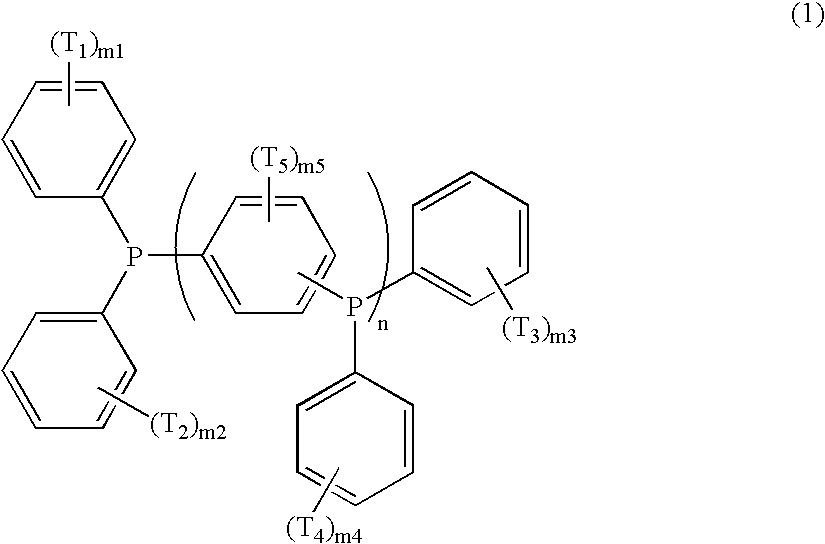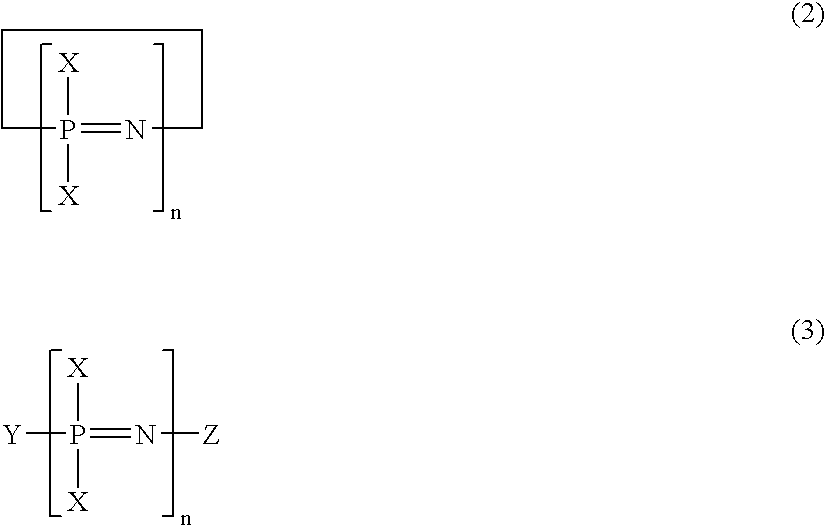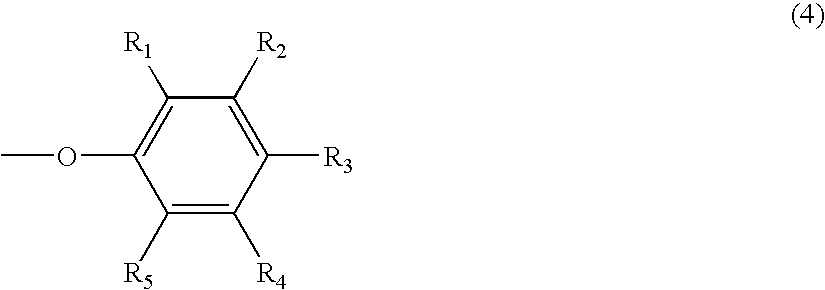Flame retarder composition
a technology of composition and flame retardant, which is applied in the direction of printed circuits, printed circuit details, circuit susbtrate materials, etc., can solve the problems of insufficient heat resistance, mechanical properties, heat resistance, dielectric properties of resins, and the appearance of molded objects, and the use of these compounds is considered undesirable, etc., to achieve excellent flame retardance, low smoke emission, and moisture absorption resistance
- Summary
- Abstract
- Description
- Claims
- Application Information
AI Technical Summary
Benefits of technology
Problems solved by technology
Method used
Image
Examples
examples
[0140] The present invention will be specifically explained by the following examples, which should not be construed as limiting the invention in any manner.
[0141] First, methods for evaluation of various properties will be explained.
1) Flame Retardance
[0142] Based on the UL-94 vertical burning test, the flame retardance was measured. That is, an injection molded test piece of about 1.6 mm or 3.2 mm thick or a hardened test piece of 2 mm thick was used, and when the test piece was allowed to contact with flame ten times, an average burning time was determined, and it was evaluated whether an absorbent cotton caught fire due to drips at the time of burning.
2) Smoke Emission at the Time of Burning
[0143] The UL-94 vertical burning test was conducted using a UL burning test chamber (HVUL-C manufactured by Toyo Seiki Seisaku-sho, Ltd.). Evaluation was visually conducted, and the results were graded as “O” when the smoke emitted at the time of the burning test hardly leaked out of ...
examples 1-3 and 23-24
, Comparative Examples 1-4 and 14-15
[0252] The epoxy resin and the component (A) in the amounts shown in Table 1 and Table 7 were mixed in an oil bath set at 130° C., and then the component (B) and, if necessary, melamine cyanurate were mixed in the oil bath set at 130° C. While keeping the temperature, mXDA was added thereto and then the mixture was cast into a mold.
[0253] Then, test pieces were molded by hardening each of the compositions for 2 minutes at 100° C. and 0 kgf / cm2, for 2 minutes at 100° C. and 10 kgf / cm2, and for 12 minutes at 100° C. and 40 kgf / cm2 by a hot press. The properties of the test pieces were evaluated to obtain the results as shown in Table 1 and Table 7.
examples 4-22 and 25-39
, Comparative Examples 5-13 and 16-19
[0254] The epoxy resin and PPE in the amounts as shown in Tables 2-6 and Tables 8-11 were dissolved, in an oil bath set at 140° C., and then the phosphazene compound was dissolved in the solution in the oil bath set at 130° C., followed by mixing with the component (A). While keeping the temperature, mXDA was added thereto and then the mixture was cast into a mold.
[0255] Then, test pieces were molded by hardening each of the compositions for 2 minutes at 100° C. and 0 kgf / cm2, for 2 minutes at 100° C. and 10 kgf / cm2, and for 12 minutes at 100° C. and 40 kgf / cm2 by a hot press. The properties of the test pieces were evaluated to obtain the results as shown in Tables 2-6 and Tables 8-11.
TABLE 1ComparativeComparativeComparativeComparativeExample 1Example 2Example 3Example 1Example 2Example 3Example 4(A)NiO / part by weight4————4—CuO / part by weight—43———4Mg(OH)2 / part by————4——weight(B)FR-1 / part by weight20——2020——FR-2 / part by weight—2020————FR-3 / part...
PUM
| Property | Measurement | Unit |
|---|---|---|
| temperature | aaaaa | aaaaa |
| temperature | aaaaa | aaaaa |
| temperature | aaaaa | aaaaa |
Abstract
Description
Claims
Application Information
 Login to View More
Login to View More - R&D
- Intellectual Property
- Life Sciences
- Materials
- Tech Scout
- Unparalleled Data Quality
- Higher Quality Content
- 60% Fewer Hallucinations
Browse by: Latest US Patents, China's latest patents, Technical Efficacy Thesaurus, Application Domain, Technology Topic, Popular Technical Reports.
© 2025 PatSnap. All rights reserved.Legal|Privacy policy|Modern Slavery Act Transparency Statement|Sitemap|About US| Contact US: help@patsnap.com



